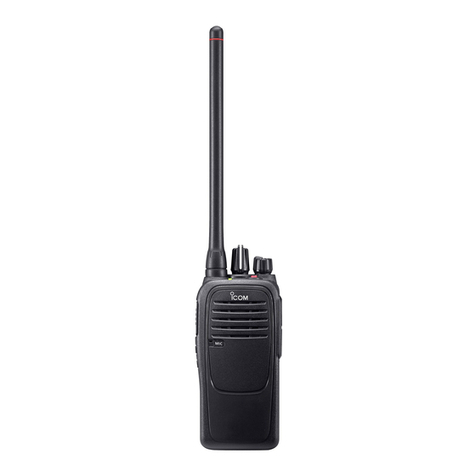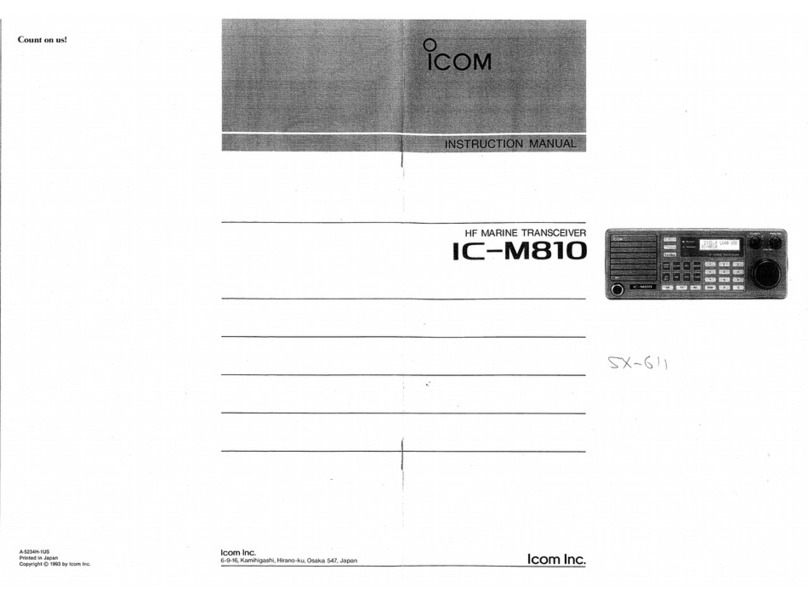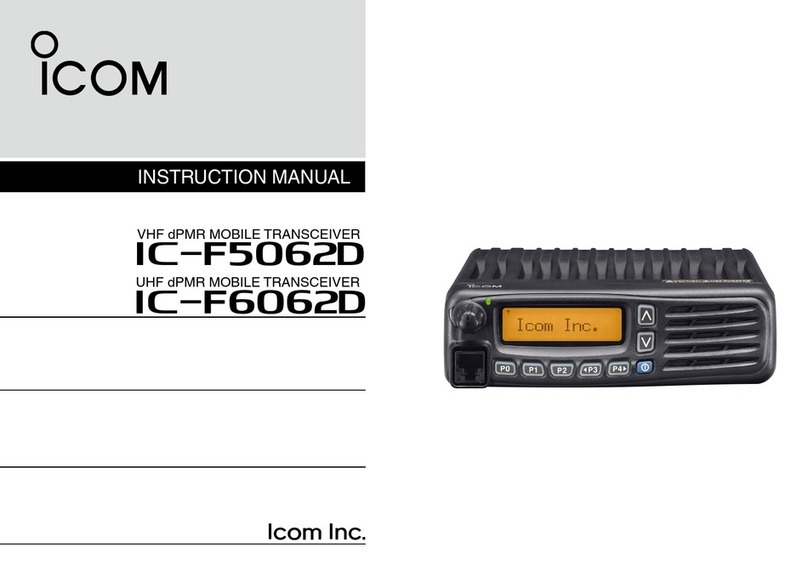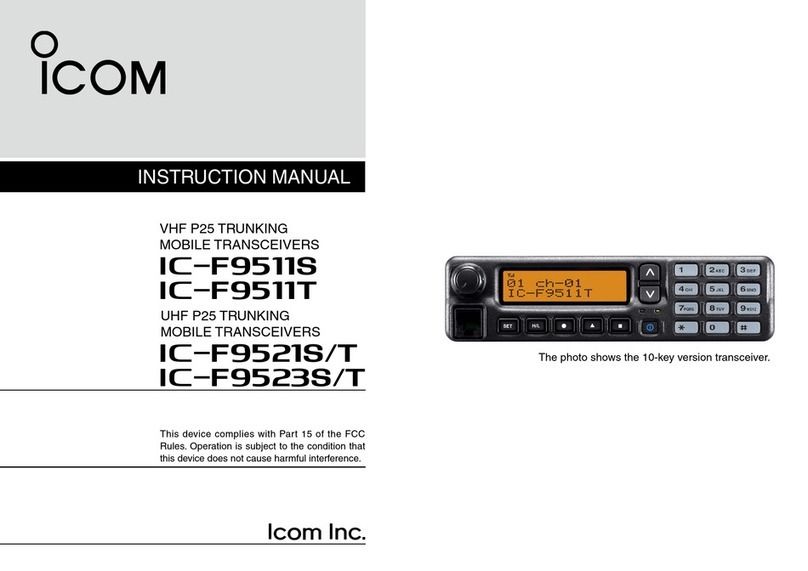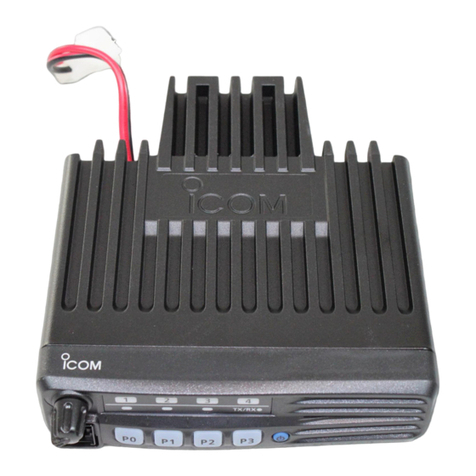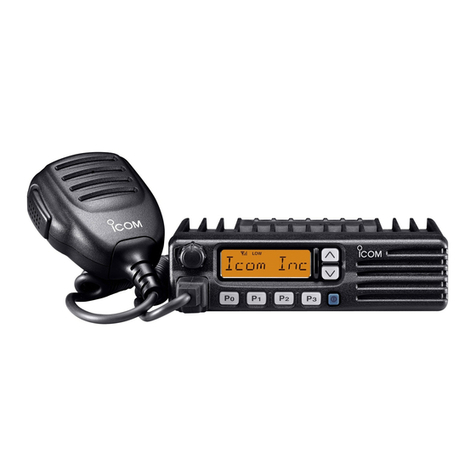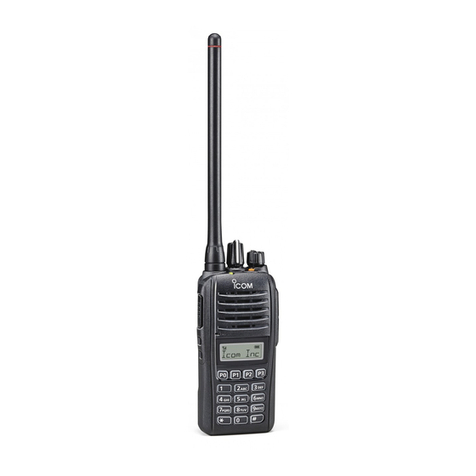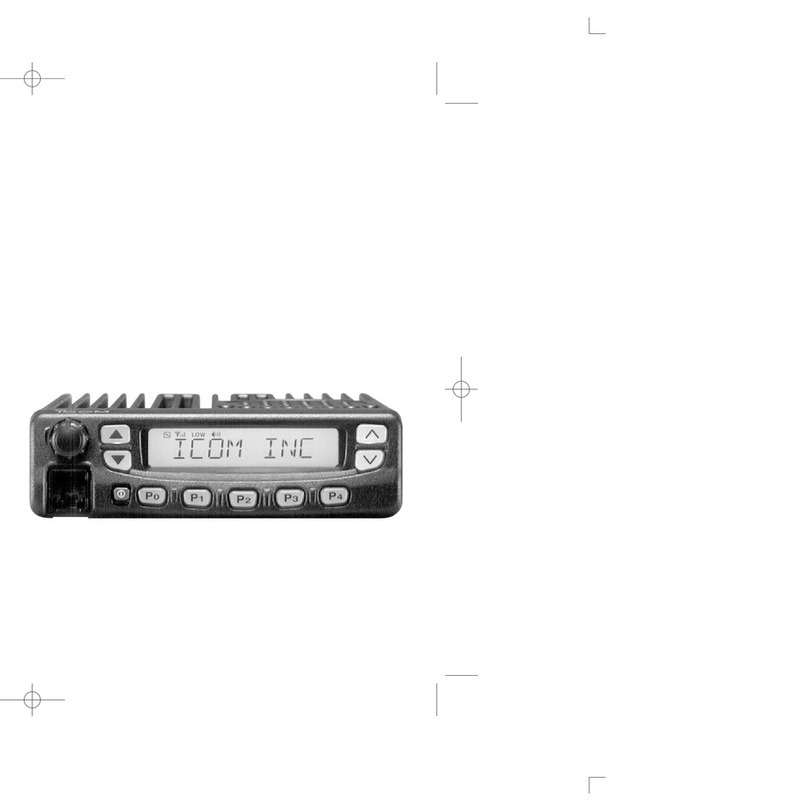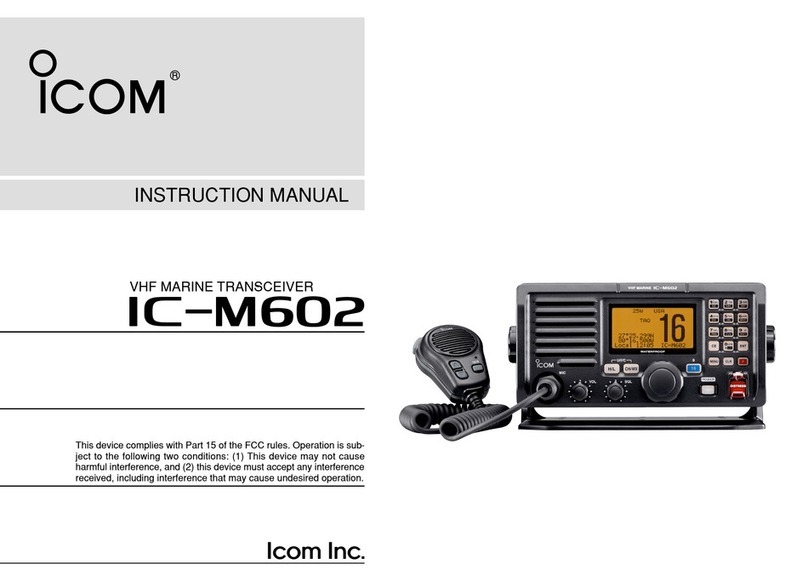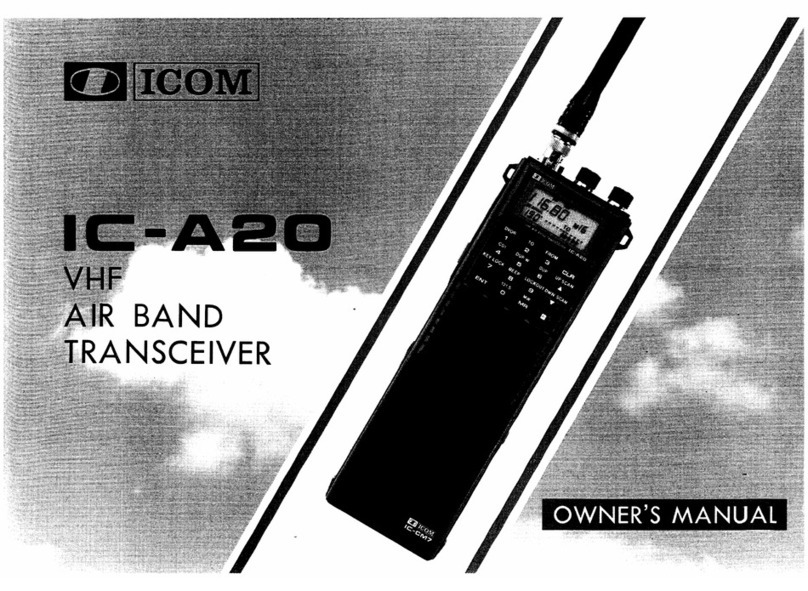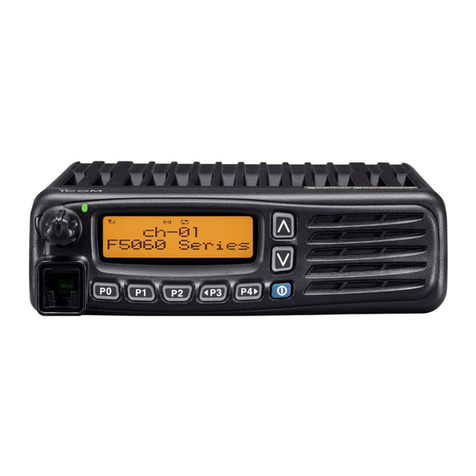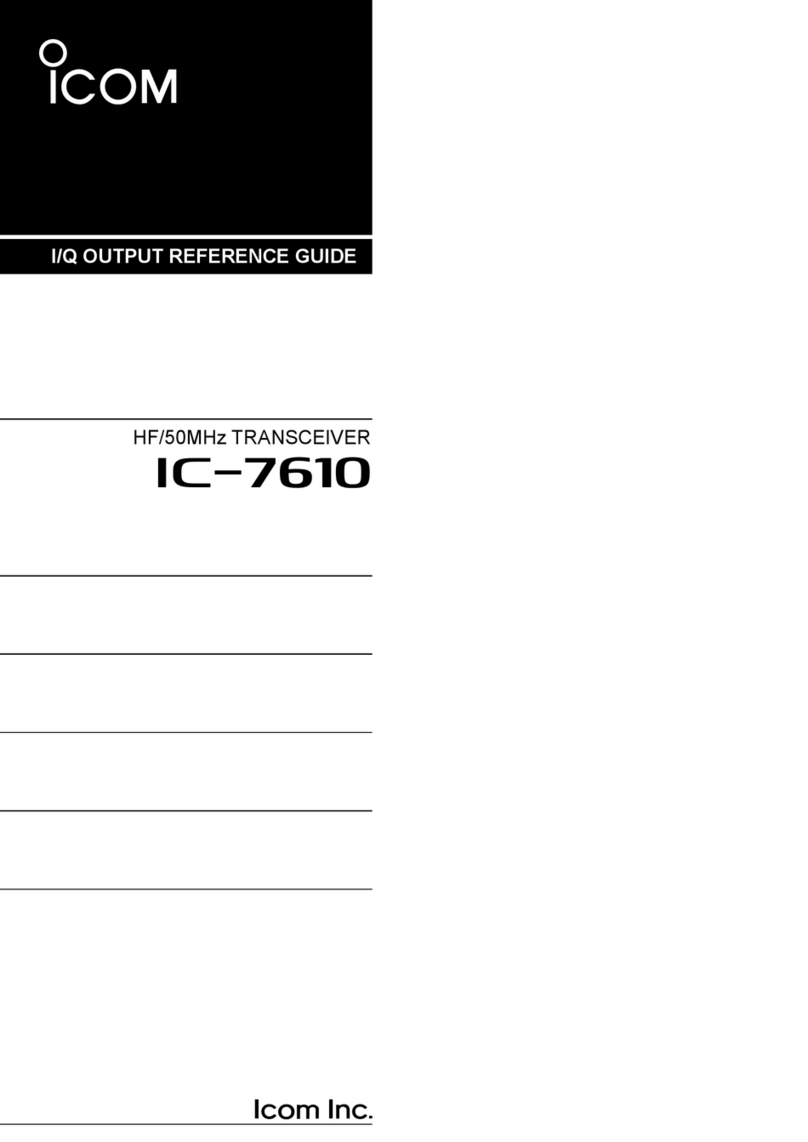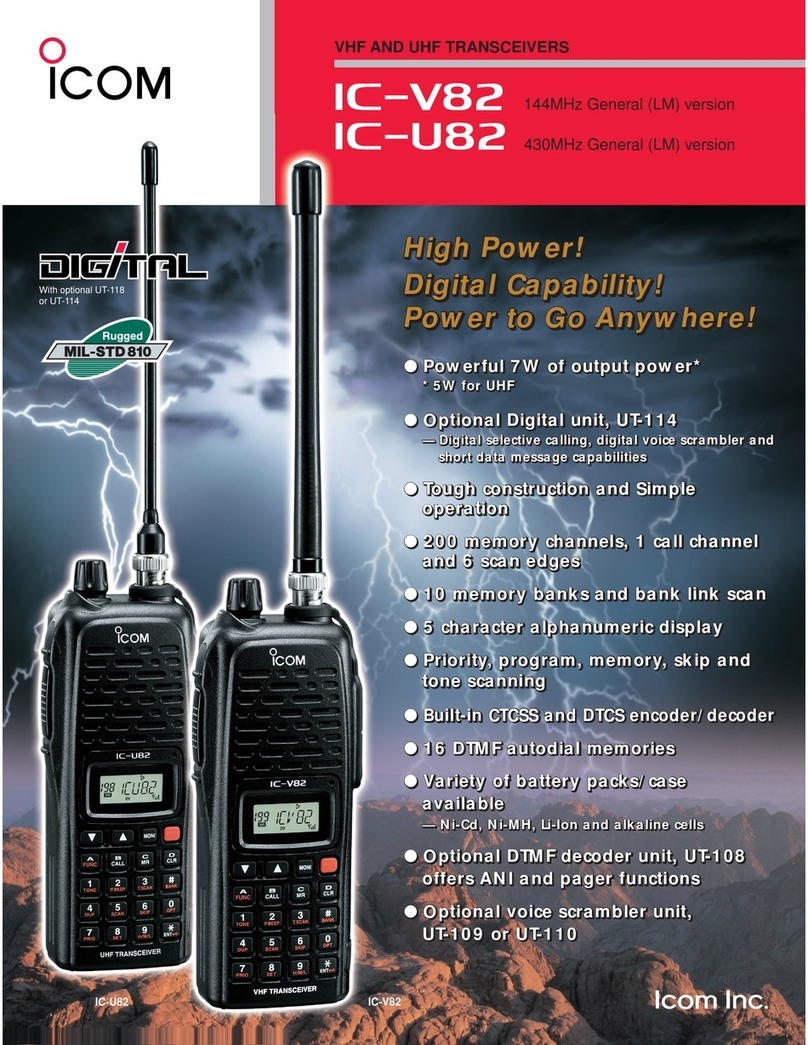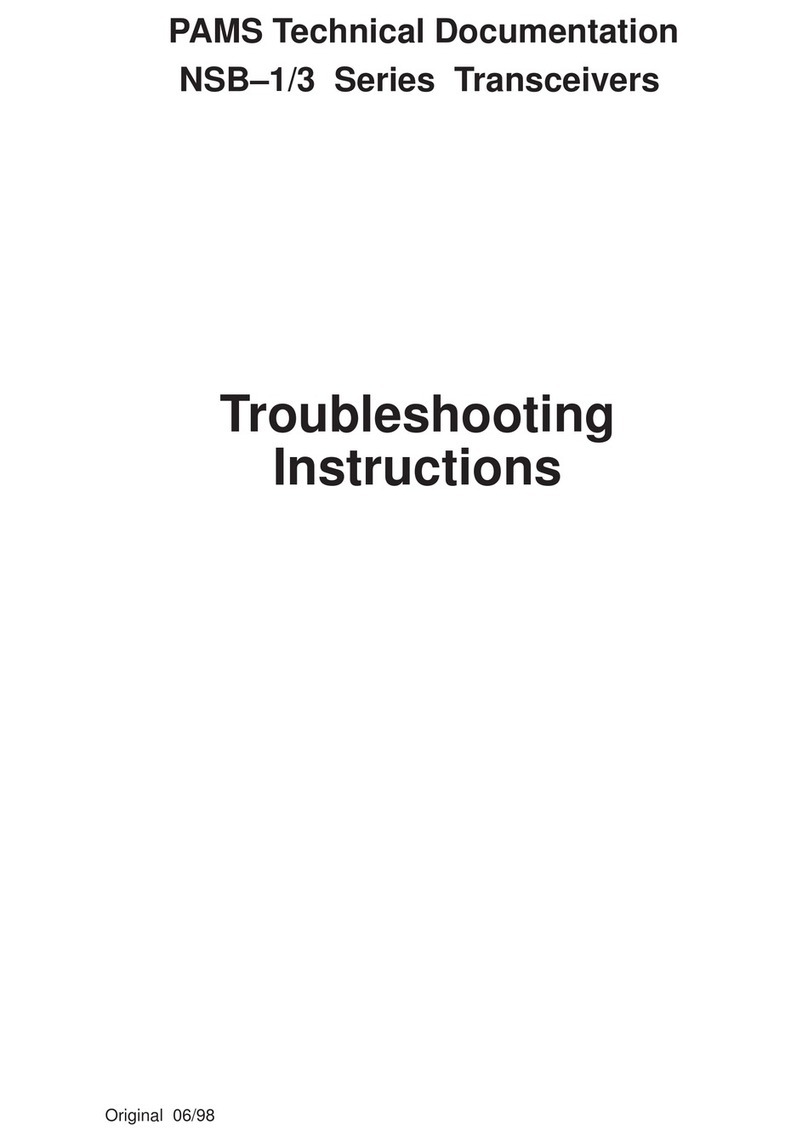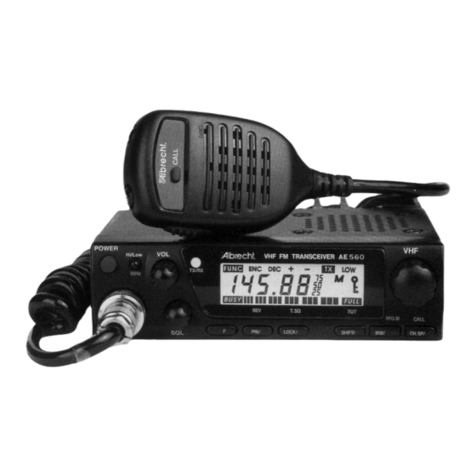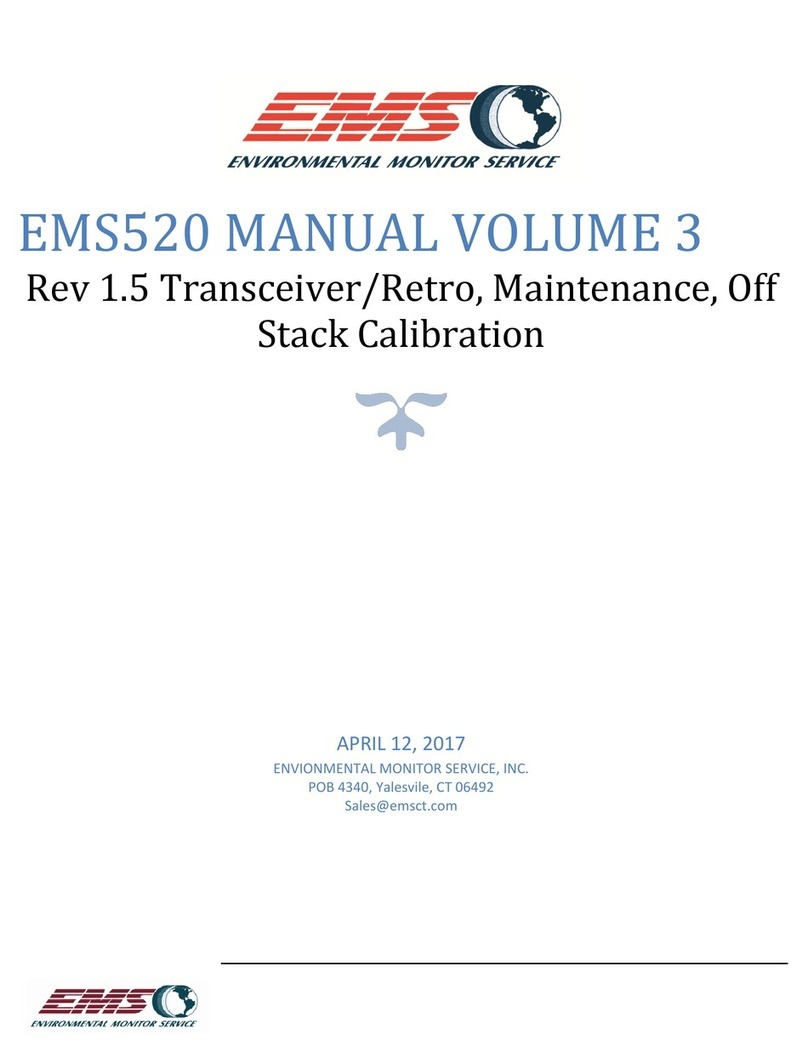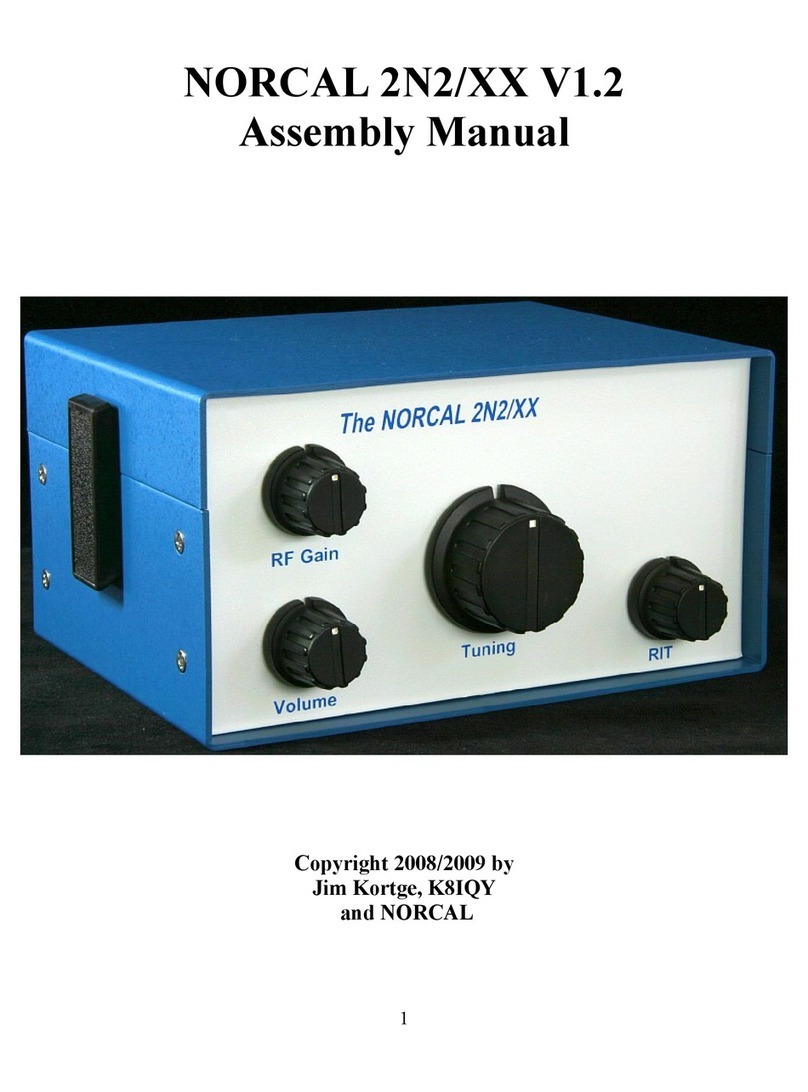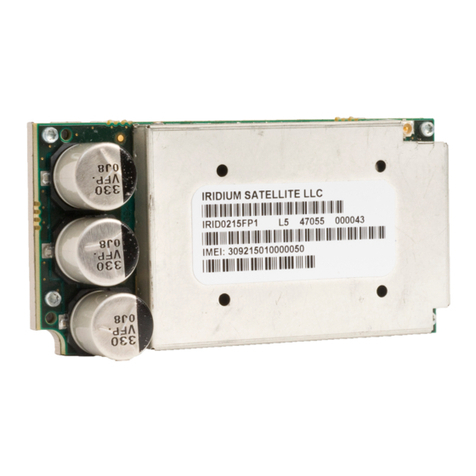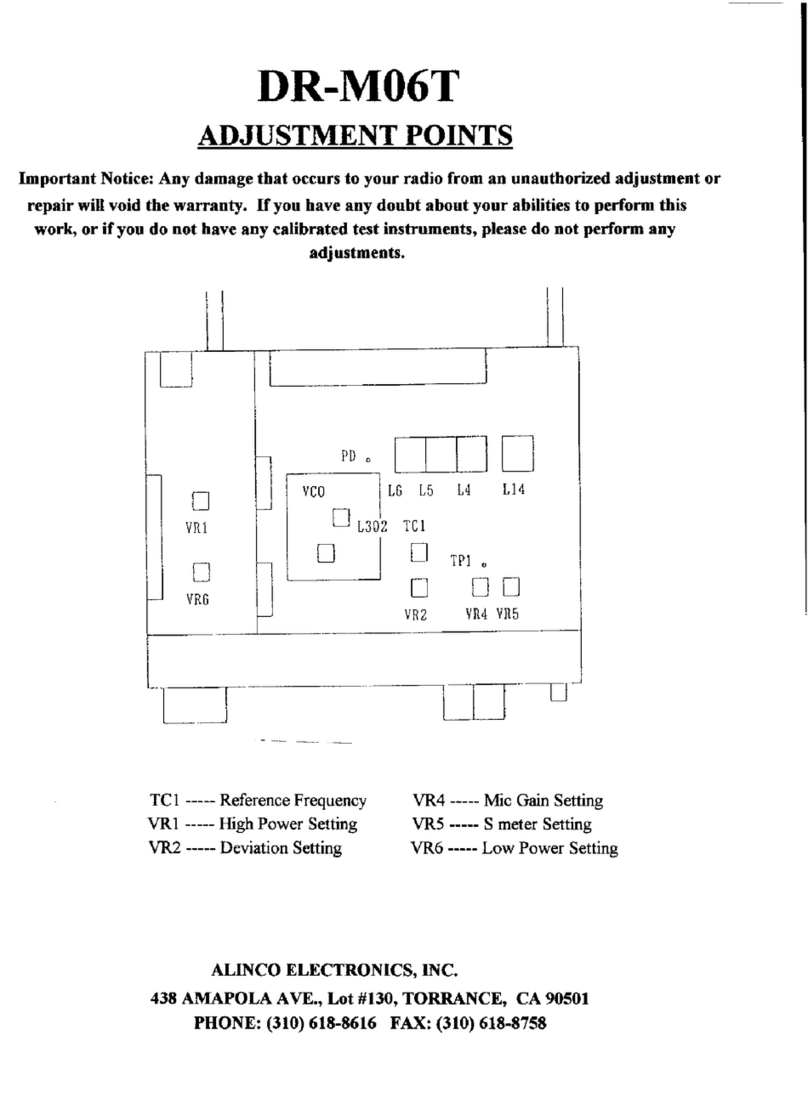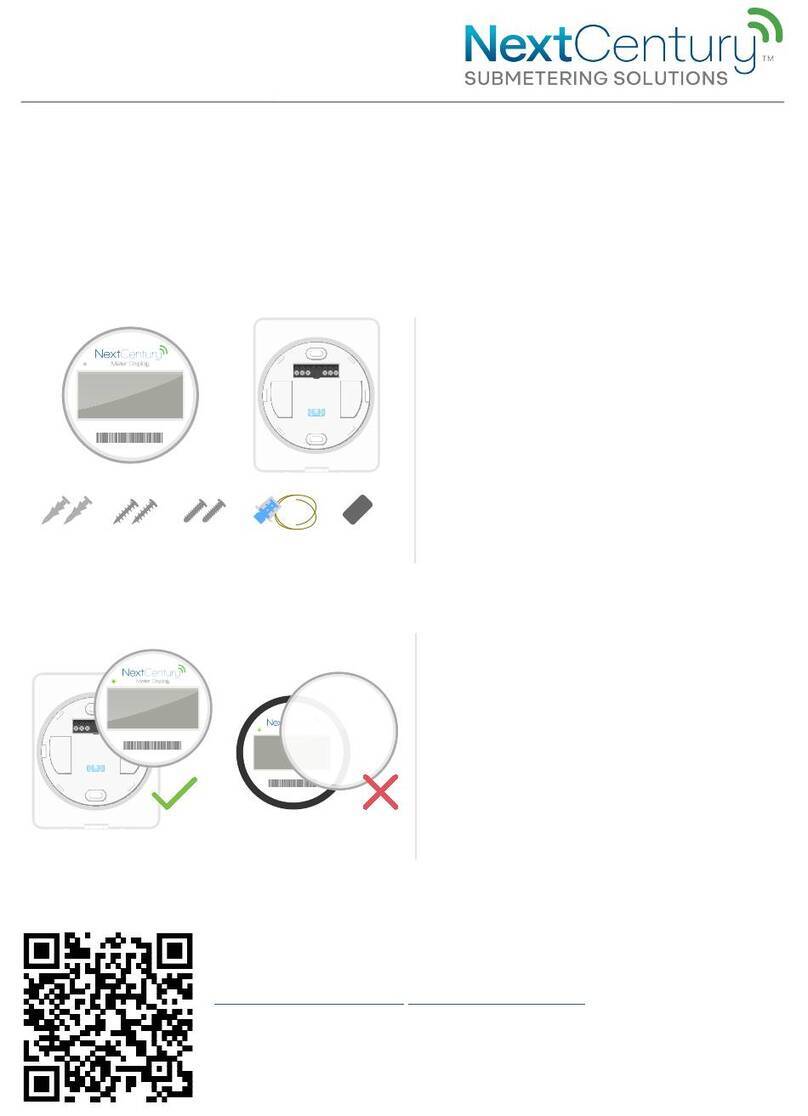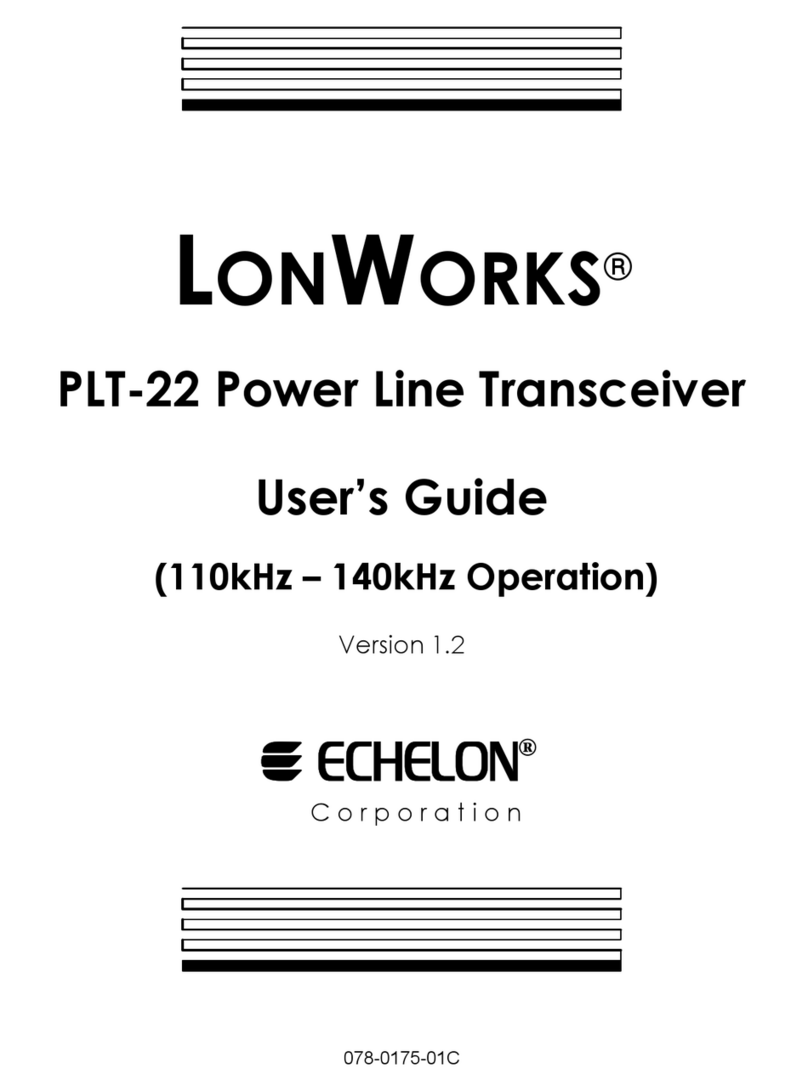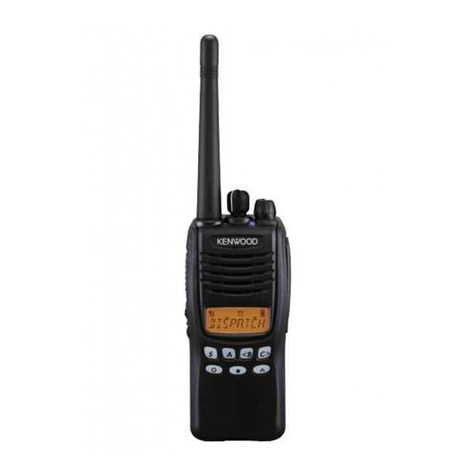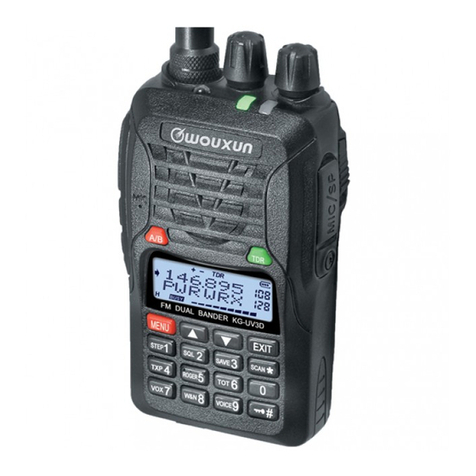Icom IC-M23 User manual

INSTRUCTION MANUAL
iM23
VHF MARINE TRANSCEIVER

ii
DOC
CE versions of the IC-M23 which display the
“CE” symbol on the serial number label, comply
with the essential requirements of the European
Radio and Telecommunication Terminal Direc-
tive 1999/5/EC.
This warning symbol indicates that this equip-
ment operates in non-harmonised frequency
bands and/or may be subject to licensing con-
ditions in the country of use. Be sure to check
that you have the correct version of this radio or
the correct programming of this radio, to comply
with national licensing requirement.
• List of Country codes (ISO 3166-1)
1 Austria AT
2 Belgium BE
3 Bulgaria BG
4 Croatia HR
5 Czech Republic CZ
6 Cyprus CY
7 Denmark DK
8 Estonia EE
9 Finland FI
10 France FR
11 Germany DE
12 Greece GR
13 Hungary HU
14 Iceland IS
15 Ireland IE
16 Italy IT
17 Latvia LV
18 Liechtenstein LI
19 Lithuania LT
20 Luxembourg LU
21 Malta MT
22 Netherlands NL
23 Norway NO
24 Poland PL
25 Portugal PT
26 Romania RO
27 Slovakia SK
28 Slovenia SI
29 Spain ES
30 Sweden SE
31 Switzerland CH
32 Turkey TR
33 United Kingdom GB
Country Codes Country Codes
DECLARATION
OF CONFORMITY
We Icom Inc. Japan
1-1-32, Kamiminami, Hirano-ku
Osaka 547-0003, Japan
Kind of equipment:
Type-designation:
Signature
Authorized representative name
Place and date of issue
Version (where applicable):
0560
Y. Furukawa
General Manager
Icom (Europe) GmbH
Communication Equipment
Auf der Krautweide 24,
65812 Bad Soden am Taunus,
Germany
VHF MARINE TRANSCEIVER
iC-
m23
31st Jan.
2011Bad Soden
Declare on our sole responsibility that this equipment complies with the
essential requirements of the Radio and Telecommunications Terminal
Equipment Directive, 1999/5/EC, and that any applicable Essential Test
Suite measurements have been performed.
This compliance is based on conformity with the following harmonised
standards, specifications or documents:
EN 301 178-2 V1.2.2 (2007-02)
EN 60945:2002
EN 60950-1:2006/A11:2009
EN 300 698-2 V1.2.1 (2009-12)
EN 300 698-3 V1.2.1 (2009-12)
i)
ii)
iii)
iv)
v)
vi)
DEC.2010

ii
IN CASE OF EMERGENCY RECOMMENDATION
If your vessel requires assistance, contact other vessels and
the Coast Guard by sending a distress call on Channel 16.
❍ USING CHANNEL 16
DISTRESS CALL PROCEDURE
1. “MAYDAY MAYDAY MAYDAY.”
2. “THIS IS ……………… ” (name of vessel)
3. Your call sign or other description of the ves-
sel.
4. “LOCATED AT …………… ” (your position)
5. The nature of the distress and assistance
required.
6. Any other information which might facilitate
the rescue.
CLEAN THE TRANSCEIVER THOROUGHLY WITH FRESH
WATER after exposure to saltwater, and dry it before operat-
ing. Otherwise, the transceiver's keys, switches and control-
lers may become unusable due to salt crystallization.
NOTE: DO NOT submerge the transceiver in water if there
is any reason to suspect the waterproof protection may not
be effective. For example, in cases where the battery cover
or [DC] jack cap rubber seal is damaged, the transceiver/
battery cover/[DC] jack cap is cracked or broken, or the
transceiver has been dropped, or when the battery cover,
antenna or DC Jack cap are detached from the transceiver.
BP-266
BP-266
BP-266

FOREWORD
Thank you for purchasing this Icom radio. The IC-M23 VHF
MARINE TRANSCEIVER is designed and built with Icom’s state of
the art technology and craftsmanship. With proper care this
radio should provide you with years of trouble-free operation.
IMPORTANT
READ ALL INSTRUCTIONS carefully and com-
pletely before using the transceiver.
SAVE THIS INSTRUCTION MANUAL—This
instruction manual contains important operating instructions
for the IC-M23.
EXPLICIT DEFINITIONS
WORD DEFINITION
RDANGER! Personal death, serious injury or an explo-
sion may occur.
RWARNING! Personal injury, fire hazard or electric
shock may occur.
CAUTION Equipment damage may occur.
NOTE
If disregarded, only inconvenience. No risk
of personal injury, fire or electric shock.
FEATURES
☞Floats on water
The transceiver floats in fresh or salt
water even when the supplied acces-
sories are attached.
• When a third-party battery pack, strap, an-
tenna, etc. is used, it may sink.
☞Floats and flashes
An LED sends out intermittent light from
a transparent section on the bottom of
the radio, while floating in the water.
As the LED light stands out in the dark
(like a flashing fishing float), the radio
can be easily retrieved from the water.
This function works even when the
radio is turned OFF.
iii

iv
RWARNING! NEVER connect the transceiver to an
AC outlet. This may pose a fire hazard or result in an electric
shock.
RWARNING! NEVER hold the transceiver so that
the antenna is closer than 2.5 cm from exposed parts of the
body, especially the face or eyes, while transmitting. The
transceiver will perform best if the microphone is 5 to 10 cm
away from the lips and the transceiver is vertical.
CAUTION: NEVER connect the transceiver to a
power source other than the BC-199 or BP-266. Such a con-
nection will ruin the transceiver.
DO NOT use or place the transceiver in direct sunlight or
in areas with temperatures below –15°C or above +55°C.
KEEP the transceiver out of the reach of children.
KEEP the transceiver at least 0.9 meters away from your
vessel’s magnetic navigation compass.
BE CAREFUL! The transceiver meets IPX7* require-
ments for waterproof protection. However, once the trans-
ceiver has been dropped, waterproof protection cannot be
guaranteed because of possible damage to the transceiver's
case or the waterproof seal.
* Only when the flexible antenna, battery cover and [DC] jack cap
are securely attached.
MAKE SURE the flexible antenna and battery cover are
securely attached to the transceiver, and that the antenna
and battery cover are dry before attachment. Exposing the
inside of the transceiver to water will result in serious dam-
age to the transceiver.
Icom, Icom Inc. and the Icom logo are registered trademarks of Icom Incor-
porated (Japan) in Japan, the United States, the United Kingdom, Germany,
France, Spain, Russia and/or other countries.
PRECAUTIONS

v
DOC................................................................................................... i
IN CASE OF EMERGENCY............................................................. ii
RECOMMENDATION ....................................................................... ii
FOREWORD ................................................................................... iii
IMPORTANT.................................................................................... iii
EXPLICIT DEFINITIONS................................................................. iii
FEATURES...................................................................................... iii
PRECAUTIONS............................................................................... iv
TABLE OF CONTENTS.................................................................... v
1 OPERATING RULES ..................................................................1
2 SUPPLIED ACCESSORIES AND ATTACHMENTS...............2–3
■Supplied accessories...............................................................2
■Attachments.............................................................................2
3 PANEL DESCRIPTION ........................................................... 4–7
■Front, top and side panels .......................................................4
■Function display.......................................................................6
4 BASIC OPERATION .............................................................8–13
■Channel selection ....................................................................8
■Adjusting the volume level .....................................................10
■Adjusting the squelch level ....................................................10
■Receiving and transmitting ....................................................11
■Call channel programming.....................................................12
■Volume Loud function ............................................................12
■Volume Mute function ............................................................12
■Lock function..........................................................................13
■Monitor function .....................................................................13
■Automatic backlighting...........................................................13
■AquaQuake Water Draining function......................................13
5 SCAN OPERATION (Except Holland version) .................14–15
■Scan types.............................................................................14
■Setting TAG channels ............................................................15
■Starting a scan.......................................................................15
6 DUALWATCH/TRI-WATCH (Except Holland version) ............16
■Description.............................................................................16
■Operation...............................................................................16
7 SET MODE..........................................................................17–20
■Set mode programming .........................................................17
■Set mode items......................................................................18
8 BATTERY CHARGING .......................................................21–25
■Battery caution.......................................................................21
■Supplied battery charger .......................................................23
■Optional battery charger ........................................................23
9 TROUBLESHOOTING .............................................................. 26
10 VHF MARINE CHANNEL LIST.................................................27
11 SPECIFICATIONS AND OPTIONS.....................................28–29
■Specifications.........................................................................28
■Options ..................................................................................29
TABLE OF CONTENTS

D Priorities
• Read all rules and regulations pertaining to call priorities,
and keep an up-to-date copy handy. Safety and distress
calls take priority over all others.
• You must monitor Channel 16 when you are not operating
on another channel.
• False or fraudulent distress calls are prohibited under law.
D Privacy
• Information overheard, but not intended for you, cannot
lawfully be used in any way.
• Indecent or profane language is prohibited.
D Radio licenses
(1) SHIP STATION LICENSE
You may require a current radio station license before using
the transceiver. It is unlawful to operate a ship station which
is not licensed, but required to be.
If required, contact your dealer or the appropriate govern-
ment agency for a Ship-Radiotelephone license application.
This government-issued license states the call sign which is
your craft’s identification for radio purposes.
(2) OPERATOR’S LICENSE
A Restricted Radiotelephone Operator Permit is the license
most often held by small vessel radio operators when a radio
is not required for safety purposes.
If required, the Restricted Radiotelephone Operator Permit
must be posted or kept with the operator. If required, only a
licensed radio operator may operate a transceiver.
However, non-licensed individuals may talk over a trans-
ceiver if a licensed operator starts, supervises, ends the call
and makes the necessary log entries.
A current copy of the applicable government rules and regu-
lations is only required to be on hand for vessels in which a
radio telephone is compulsory. However, even if you are not
required to have these on hand it is your responsibility to be
thoroughly acquainted with all pertinent rules and regula-
tions.
1
1
OPERATING RULES
1
2
3
4
5
6
7
8
9
10
11
12
13
14
15
16

2
SUPPLIED ACCESSORIES AND ATTACHMENTS
2
■Supplied accessories
■Attachments
DFlexible antenna
Connect the supplied flexible an-
tenna to the antenna connector.
CAUTION:
• NEVER carry the transceiver by
holding just the antenna.
• Transmitting without an antenna
can damage the transceiver.
DHandstrap
Pass the handstrap through
the loop on the back side of
the transceiver as shown.
DBelt clip
Attach the belt clip to, or detach the belt clip from the transceiver.
Battery packHandstrap
Belt clip
Flexible antenna
Charger*
BP-266
BP-266
BP-266
*Not supplied or different types are supplied, depending on the version.
BP-266
BP-266
BP-266
BP-266
BP-266
BP-266
To attach the belt clip To detach the belt clip
Be careful!
Don’t break your
fingernail.
q
Belt clip
w
BP-266
BP-266
Lift the tab up (q), and slide
the belt clip in the direction
of the arrow (w).
BP-266

Make sure the rubber seal is properly seated in the
groove and there is dust or other material is on it.
BP-266
BP-266
Rubber seal
Groove
Battery cover Battery cover
Correct position Incorrect position
BP-266
DBattery pack
To remove the battery pack:
Slide the latch and then lift the battery cover to remove it.
Then remove the battery pack, as shown.
To insert the battery pack:
Place the battery pack into the transceiver so it fits flat, and
then securely attach
the battery cover, as shown.
NEVER remove the
battery cover
when the transceiver is
wet or soiled. This may result in water or dust getting into
the transceiver/battery pack, and may result in the trans-
ceiver being damaged.
CAUTION:
•
When attaching or removing the battery cover, make sure
the rubber seal is correctly set in the groove of the cover.
If the seal is not correctly in the groove, it may be dam-
aged when attaching the battery cover. If the seal is dam-
aged, waterproof protection is not guaranteed.
•
When attaching the battery cover, make sure dust or
other material does not adhere to the rubber seal. If dust
or other material is on the seal when attaching the battery
cover, waterproof protection may not be guaranteed.
3
2
SUPPLIED ACCESSORIES AND ATTACHMENTS
1
2
3
4
5
6
7
8
9
10
11
12
13
14
15
16
BP-266
BP-266
Latch
Battery cover
BP-266
BP-266
BP-266
Push the cover until
the latch comes back
to the locked position.
Battery cover
“Click”
BP-266
BP-266
BP-266
Battery pack
BP-266

4
PANEL DESCRIPTION
3
■
Front, top and side panels
qANTENNA CONNECTOR (p. 2)
Connect the supplied antenna here.
w
DC JACK [DC] (p. 23)
Connect the charger or optional cable here.
NOTE: Attach the [DC] jack cap when the charger or op-
tional cable is not connected. Otherwise, water will get into
the transceiver. When attaching the [DC] jack cap, make
sure dust or other material does not adhere to the rubber
seal. If dust or other material is on the seal when attaching
the cap, waterproof protection may not be guaranteed.
e PTT SWITCH [PTT]
Hold down to transmit; release to receive. (p. 11)
rCHANNEL 16 KEY [16 C]
➥Push to select Channel 16. (p. 8)
➥
Hold down for 1 second to select the Call channel. (p. 8)
➥
When the Call channel is selected, hold down for 3 seconds
to enter the Call channel programming mode.(p. 12)
➥While in the Set mode, push to return to the normal op-
erating mode.(p.17)
Function
display
(pp. 6, 7)
Speaker
y
t
r
e
u
w
q
!1
o
i
!0
Microphone
BP-266
BP-266
BP-266
qTo remove the
[DC]
jack cap, rotate it
counter clockwise.
BP-266
BP-266
BP-266
wPull the cap up to detach it.
BP-266
BP-266
BP-266

t VOLUME/SQUELCH/MONITOR KEY [VOL/SQL MONI]
➥Push to enter the volume adjustment mode or the
squelch adjustment mode. (p. 10)
➥Hold down for 1 second to activate the Monitor func-
tion. (p. 13)
➥While holding down this key, hold down []to turn ON
the power and enter the Set mode. (p. 17)
➥While in the Set mode, push to select an item. (p. 17)
➥While holding down this key, push [Z] to turn ON the
Volume Mute function. Do the same steps again to turn
OFF the function. (p. 12)
➥While holding down this key, push [Y] to turn ON the
Volume Loud function. Do the same steps again to turn
OFF the function. (p. 12)
ySCAN/DUAL KEY [SCAN DUAL]
➥Push to start or stop a normal or priority scan. (p. 15)
➥
Hold down for 1 second to enter the Dual/Tri-watch
mode. (p. 16)
➥Push to exit the watch mode. (p. 16)
➥Hold down this key and
[Hi/Lo]
for 1 second, to activate
the Aq
uaQuake function. (p. 13)
uUP/DOWN KEYS [Y]or [Z]
➥Push to select an operating channel. (pp. 8, 9)
➥While in the Set mode, push to select the setting or
value of an item. (p. 17)
➥Push to check TAG channels or change scanning direc-
tion during a scan. (p. 15)
iFAVORITE/TAG KEY [FAV TAG]
➥Push to sequentially select the favorite (TAG) chan-
nels, while ignoring untagged channels, in a channel
group. (p. 8)
➥Hold down for 1 second to set or clear the TAG for the
displayed channel. (p. 15)
➥While holding down, turn ON the power to clear or set
all TAG channels in the selected channel group. (p. 15)
oCHANNEL KEY [CH]
➥Hold down for 1 second, one or more times, to select
a channel group from USA*1, International, Canada*2
and ATIS*3. (p. 9)
➥Push to return to the previous channel before selecting
Channel 16 or the Call channel. (p. 8)
*1U.K. and China versions only.
*2China version only.
*3German and Holland versions only.
!0 POWER KEY [ ]
Hold down to turn power ON or OFF.
!1 TRANSMIT POWER/LOCK KEY [Hi/Lo ]
➥
Push to
select the
high
or
low
output power
.
(p.11)
➥Hold down for 1 second to turn the Lock function ON or
OFF. (p. 13)
5
3
PANEL DESCRIPTION
1
2
3
4
5
6
7
8
9
10
11
12
13
14
15
16
Volume adjustment mode
Normal operating mode
Squelch adjustment mode
PUSH
PUSH
PUSH
BP-266
BP-266
BP-266

6
3PANEL DESCRIPTION
■Function display
q TRANSMIT ICON (p. 11)
Appears while transmitting.
w BUSY ICON
➥Appears while receiving a signal or when the squelch
opens. (p. 11)
➥Blinks while monitoring. (p. 13)
e TAG CHANNEL ICON (p. 15)
Appears when a TAG channel is selected.
r CALL CHANNEL ICON (p. 8)
Appears when the Call channel is selected.
t CHARGE ICON (p. 23)
Appears while charging.
y BATTERY ICONS
➥Displays the remaining battery capacity.
Indication
Full Middle Charging
required Exhausted
Battery status
blinks when the battery is over charged.
BP-266
BP-266
BP-266
➥Scrolls while charging. (p. 23)
u SCAN ICON (p. 15)
Blinks during a scan.
i LOCK ICON (p. 13)
Appears when the Lock function is turned ON.
o DUALWATCH/TRI-WATCH ICONS (p. 16)
“DW” appears during Dualwatch; “TW” appears during Tri-
watch.
!0 DUPLEX ICON
Appears when a duplex channel is selected.
!4
!3
i
u
o
!2
!1
!0
!7
!5
qerytw
!6
BP-266
BP-266
BP-266
BP-266
BP-266
BP-266

!1 SUB CHANNEL READOUT
➥Displays Channel 16 during a priority scan, Dualwatch
or Tri-watch. (p. 16)
➥Displays the Set mode item while in the Set mode. (p. 17)
➥Displays the volume level while in the volume adjust-
ment mode. (p. 10)
➥Displays the squelch level while in the squelch adjust-
ment mode. (p. 10)
!2 SQUELCH LEVEL ICON
➥Displays the squelch level.
➥“ SQL” blinks while adjusting the squelch level. (p. 10)
!3 VOLUME LEVEL ICON
➥Displays the volume level.
➥The bars repeatedly appear in ascending order when
the Volume Loud function is turned ON. (p. 12)
➥The bars blink while the Volume Mute function is turned
ON. (p. 12)
➥“ VOL” blinks while adjusting the volume level. (p. 10)
!4 CHANNEL NUMBER READOUT
➥Displays the selected operating channel number.
➥
In the Set mode, displays the selected setting or value.
(p. 17)
!5 CHANNEL GROUP ICON (p. 9)
“” appears when USA; “ ” appears when International;
“” appears when Canadian channel group is selected.
!6 ATIS ICON (p. 9)
“ATIS” appears when the channel group, which ATIS func-
tion is activated, is selected.
(Available with German and Holland versions only.)
!7 LOW POWER ICON (p. 11)
➥“ LOW” appears when low power is selected.
➥“LOW” blinks when switching to the low power mode is
forced because of a high temperature error or low volt-
age.
7
3
PANEL DESCRIPTION
1
2
3
4
5
6
7
8
9
10
11
12
13
14
15
16

8
BASIC OPERATION
4
■Channel selection
IMPORTANT: Prior to using the transceiver for the first
time, the battery pack must be fully charged for optimum
life and operation (p. 23). To avoid damage to the trans-
ceiver, turn OFF the power while charging.
DChannel 16
Channel 16 is the distress and safety channel. It is used for
establishing initial contact with a station, and for emergency
communications. Channel 16 is monitored during both Du-
alwatch and Tri-watch. While in the standby mode, you must
monitor Channel 16.
qPush [16] momentarily to select Channel 16.
wPush [CH] to return to the channel used before selecting
Channel 16, or push [Y]or [Z]to select a different chan-
nel.
Convenient!
While holding down [FAV], push [Y]or [Z] to select the fa-
vorite (TAG) channels.
• Pushing [FAV] only advances the displayed TAG channel.
• The favorite channels are selected using the TAG channel setting.
(p. 15)
DCall channel
Each regular channel group has a separate leisure-use Call
channel. The Call channel is monitored during Tri-watch. The
Call channels can be programmed, and are used to store
your most often used channel in each channel group, for
quick recall. (p. 12)
qHold down [C] (16) for 1 second to select the Call chan-
nel of the selected channel group.
• “CALL” and the Call channel number appear.
wPush [CH] to return to the channel used before selecting
the Call channel, or push [Y]or [Z]to select a different
channel.
Push
Hold down
for 1 second

DUSA, International, Canadian and ATIS channels
The transceiver is pre-programmed with USA*1, Interna-
tional, Canadian*2and ATIS*3channels. Choose the appro-
priate channel groups for your operating area.
qPush [CH] to select a regular channel.
wHold down [CH] for 1 second, one or more times, to se-
lect the desired channel group.
• The selectable channel groups are different, depending on the
version.
ePush [Y]or [Z]to select a channel.
• “DUP” appears for duplex channels.
• “A” appears when a simplex channel is selected.
*1U.K. and China versions only.
*2China version only.
*3German and Holland versions only.
For UK version
For German and Holland versions
For China version
9
4
BASIC OPERATION
1
2
3
4
5
6
7
8
9
10
11
12
13
14
15
16
USA channels
International channels
Hold down
for 1 second
ATIS channels
International channels
Hold down
for 1 second
Hold down
USA channels
International channels
Canadian channels
for 1 second

10
4BASIC OPERATION
■Adjusting the volume level
The volume level can be adjusted using [VOL/SQL] and [Y]
or [Z].
q
Push [VOL/SQL] once to enter the volume adjustment
mode, then push [Y]or [Z]to adjust the volume level.
• The “VOL” icon starts blinking.
• The transceiver has 31 volume levels and OFF.
• When no key operation is performed for 5 seconds, the trans-
ceiver returns to the normal mode.
wPush
[VOL/SQL]
twice to exit the volume adjustment
mode.
■Adjusting the squelch level
The squelch level can be adjusted using [VOL/SQL] and [Y]
or [Z].
In order to properly receive signals, as well as for the scan
to effectively function, the squelch must be adjusted to the
proper level.
q
Push
[VOL/SQL]
twice to enter the squelch adjustment
mode, then push [Y]or [Z]to adjust the squelch level.
• The “SQL” icon starts blinking.
• The transceiver has 11 squelch levels: OP is completely open;
10 is tight squelch; 1 is loose squelch.
• When no key operation is performed for 5 seconds, the trans-
ceiver returns to the normal mode.
wPush
[VOL/SQL]
again to exit the squelch adjustment
mode.
Displays the
volume level.
Blinks in the volume adjustment mode.
Displays the
squelch level.
Blinks in the squelch adjustment mode.

■Receiving and transmitting
CAUTION: Transmitting without an antenna can damage
the transceiver.
q Hold down []to turn ON the power.
w Set the volume and squelch levels.
You can enter each adjustment mode by pushing [VOL/
SQL].
➥ Enter the squelch adjustment mode, and then push [Z]one or
more times to open the squelch.
➥Enter the volume adjustment mode, and then push [Y] or [Z]
to adjust the volume level.
➥Enter the squelch adjustment mode again, and push [Y]until
the noise just disappears.
e
Push [VOL/SQL] again to exit the squelch adjustment mode.
r Push [Y]or [Z]to select a desired channel.
• When receiving a signal, “ ” appears and audio is heard
from the speaker.
• You may want to further adjust the audio level.
t Push [Hi/Lo] to select the output power if necessary.
• “LOW” appears when low power is selected; no icon is
displayed when high power is selected.
• Choose low power for short range communications; choose
high power for longer distance communications.
• Some channels are for only low power communication.
y
Hold down [PTT] to transmit, then speak into the microphone.
• “ ” appears.
• Channel 70 cannot be used for transmission.
u Release [PTT] to receive.
IMPORTANT: To maximize the readability of your trans-
mitted signal, pause for a second after pushing [PTT],
hold the microphone 5 to 10 cm from your mouth and
speak into the microphone at a normal voice level.
NOTE: To conserve battery power, the transceiver’s
Power Save function automatically activates when no sig-
nal is received for 5 seconds.
11
4
BASIC OPERATION
1
2
3
4
5
6
7
8
9
10
11
12
13
14
15
16
BP-266
Microphone
tSet output
power.
qPower ON.
yPush to
transmit.
uRelease to
receive.
rSet channel.
Enter the volume
and squelch ad-
justment mode.
w
Exit the squelch
adjustment mode.
e
wAdjust the
volume and
squelch
level.
BP-266
BP-266

12
4BASIC OPERATION
■Call channel programming
Call channel is used to access Channel 16 (default; may dif-
fer depending on the version). However, you can program
the Call channel with your most often-used channel in each
channel group, for quick recall.
qHold down [CH] for 1 second, one or more times, to se-
lect the desired channel group to be programmed. (p. 9)
wHold down [C] (16) for 1 second to select the Call chan-
nel of the selected channel group.
• “CALL” and the Call channel number appear.
eHold down [C] (16) again for 3 sec-
onds (until a long beep changes
to 2 short beeps) to enter the Call
channel programming mode.
• The channel number starts blinking.
rPush [Y]or [Z]to select the desired channel.
tPush [C] (16) to program the dis-
played channel as the Call channel.
• The channel number stops blinking.
■Volume Loud function
The Volume Loud function temporarily maximizes the vol-
ume level.
This function has no effect when the volume level is 31.
qWhile holding down [VOL/SQL], push [Y]to turn ON the
Volume Loud function.
• The volume level is set to the maximum level (level 31).
• The bars of the volume level icon repeatedly appear in ascend-
ing order.
wPush [VOL/SQL] and [Y]again to turn OFF the Volume
Loud function.
■Volume Mute function
The Volume Mute function temporarily mutes the audio output.
This function has no effect when the volume level is OFF.
qWhile holding down [VOL/SQL], push [Z]to turn ON the
Volume Mute function.
• The volume level is set to the minimum level (OFF).
• The bars of the volume level icon blink.
wPush [VOL/SQL] and [Z]again to turn OFF the Volume
Mute function.

■Lock function
This function electronically locks all keys (except for [PTT], [VOL/
SQL], [MONI] (VOL/SQL), [](Hi/Lo) and [Y]or [Z]*) to pre-
vent accidental changing of the channel and function access.
* Only in the volume or squelch adjustment mode, and volume loud
and Volume Mute functions.
➥Hold down
[ ]
(Hi/Lo) for 1 second to turn the Lock
function ON and OFF.
■Monitor function
The Monitor function opens the squelch. The monitor key ac-
tion can be selected in the Set mode. (p. 19)
➥The Monitor function is activated by holding down
[MONI]
(VOL/SQL)
.
• “ ” blinks and the squelch opens.
■Automatic backlighting
This function lights the function display and keys, and is con-
venient for night-time operation. The automatic backlighting
can be activated in the Set mode. (p. 19)
➥Push any key except for [PTT] to turn ON the backlight.
• The backlight is automatically turned OFF after 5 seconds of
inactivity.
■
AquaQuake Water Draining function
The AquaQuake Water Draining function removes water
from the speaker grill. Without this function, water may muffle
the sound coming from the speaker. The transceiver makes
a vibrating sound when this function is activated.
➥Hold down both [SCAN] and [Hi/Lo].
• A low vibration tone sounds for 9 seconds to drain water, re-
gardless of the volume level setting.
• The transceiver does not accept key operations while the
AquaQuake Water Draining function is activated.
13
4
BASIC OPERATION
1
2
3
4
5
6
7
8
9
10
11
12
13
14
15
16
Appears while the Lock function is activated.
Hold down
for 1 second
Blinks while the monitor function is activated.
Hold down

14
SCAN OPERATION (Except Holland version)
5
■Scan types
Scanning is an efficient way to quickly locate signals over a
wide frequency range. The transceiver has a priority scan
and a normal scan.
In addition, the Auto Scan function is selectable for standby
convenience. This function can be simultaneously activated,
depending on the setting in the Set mode. (p. 18)
Set the TAG channels (scanned channels) before scanning.
Clear the TAG for unwanted channels which inconveniently
stop scanning, such as those for digital communications. (p. 15)
Choose the desired scan type from "Priority" or "Normal" in
the Set mode. (p. 18)
PRIORITY SCAN
A priority scan sequentially searches through all TAG
channels while monitoring Channel 16. When a signal is
detected on Channel 16, the scan pauses until the signal
disappears; when a signal is detected on a channel other
than Channel 16, the scan switches to Dualwatch, until
the signal disappears.
NORMAL SCAN
A normal scan, like a priority scan, sequentially searches
through all TAG channels. However, unlike a priority scan,
Channel 16 is not checked unless Channel 16 is set as a
TAG channel.
CH 88
CH 01
CH 16
CH 02
CH 05 CH 04
CH 03
CH 01 CH 02
CH 88
CH 05 CH 04
CH 03
Other manuals for IC-M23
1
This manual suits for next models
1
Table of contents
Other Icom Transceiver manuals
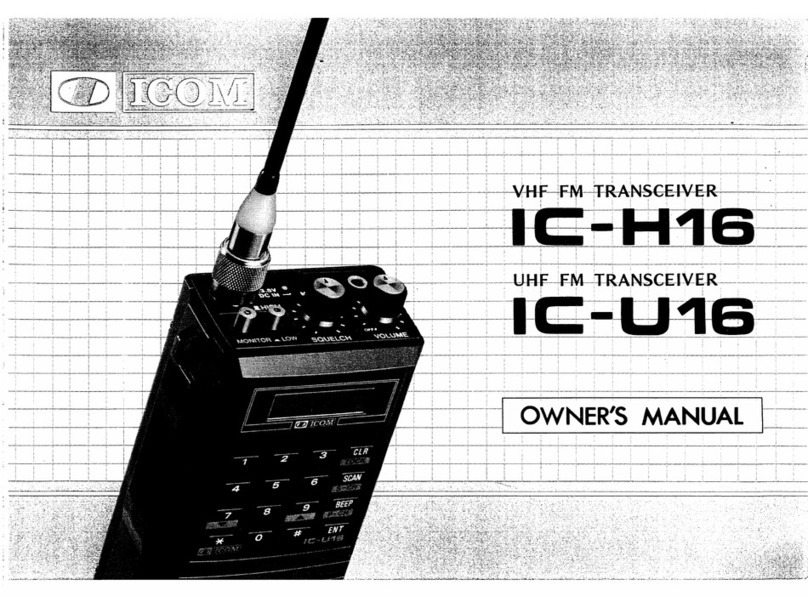
Icom
Icom IC-H16 User manual
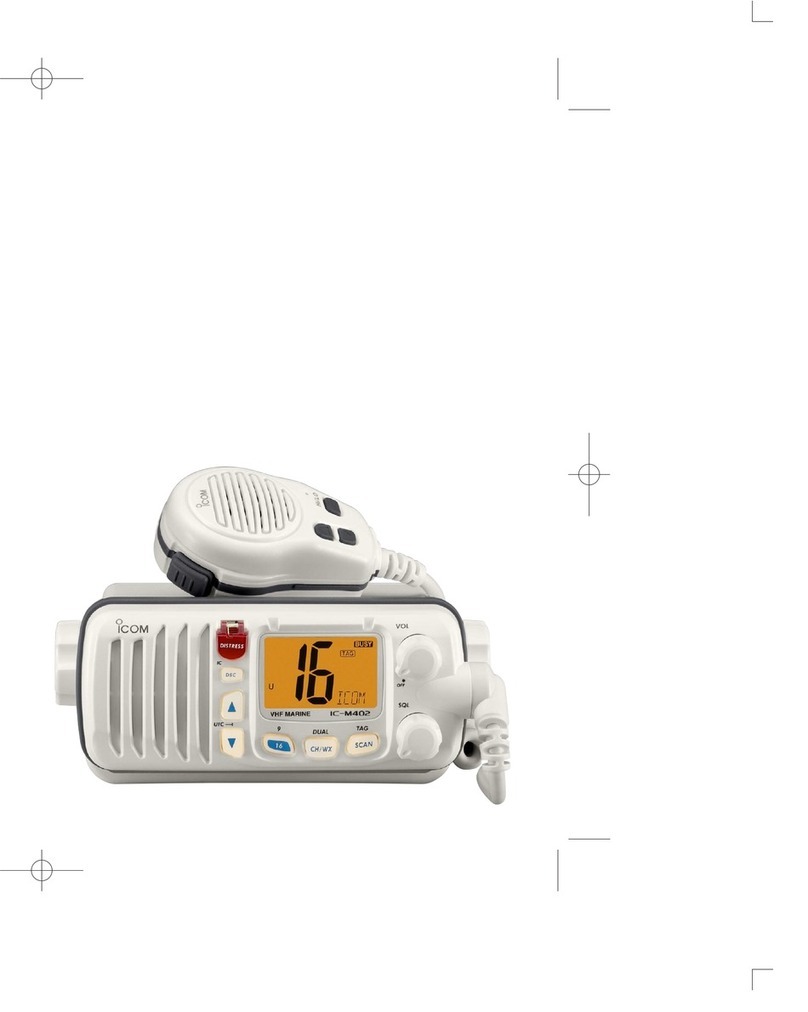
Icom
Icom IC-M402A User manual
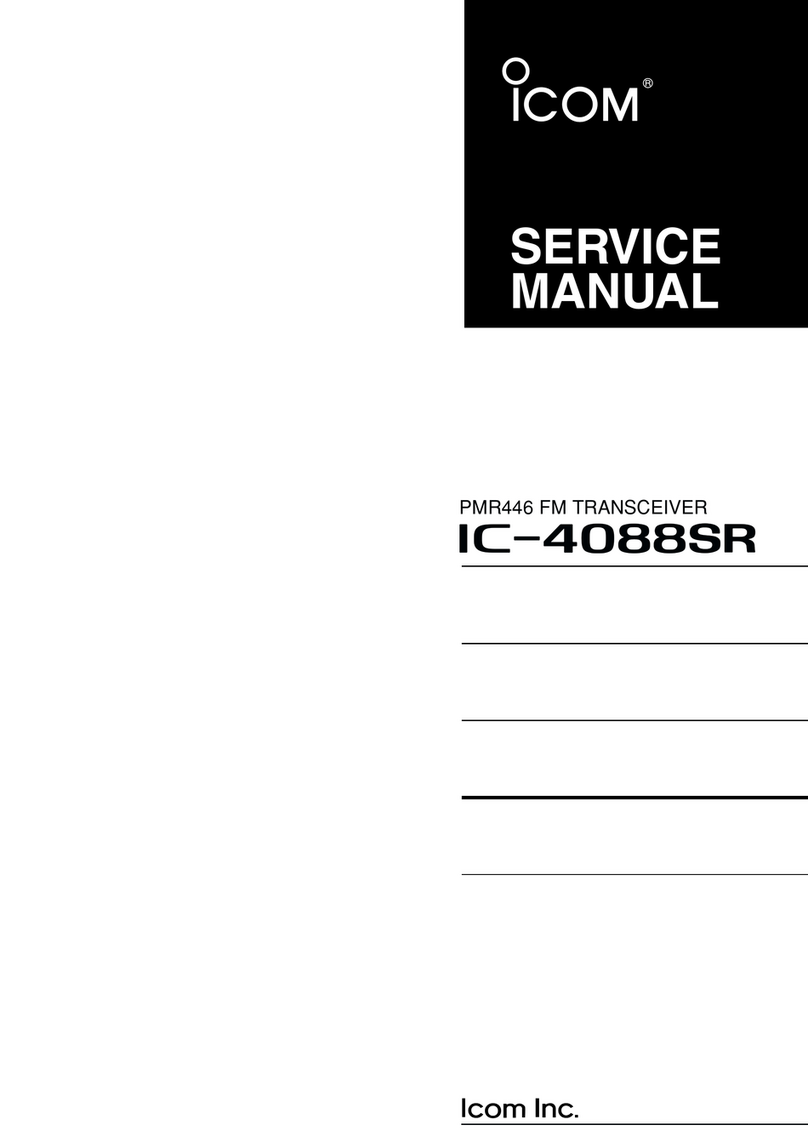
Icom
Icom IC-4088SR User manual
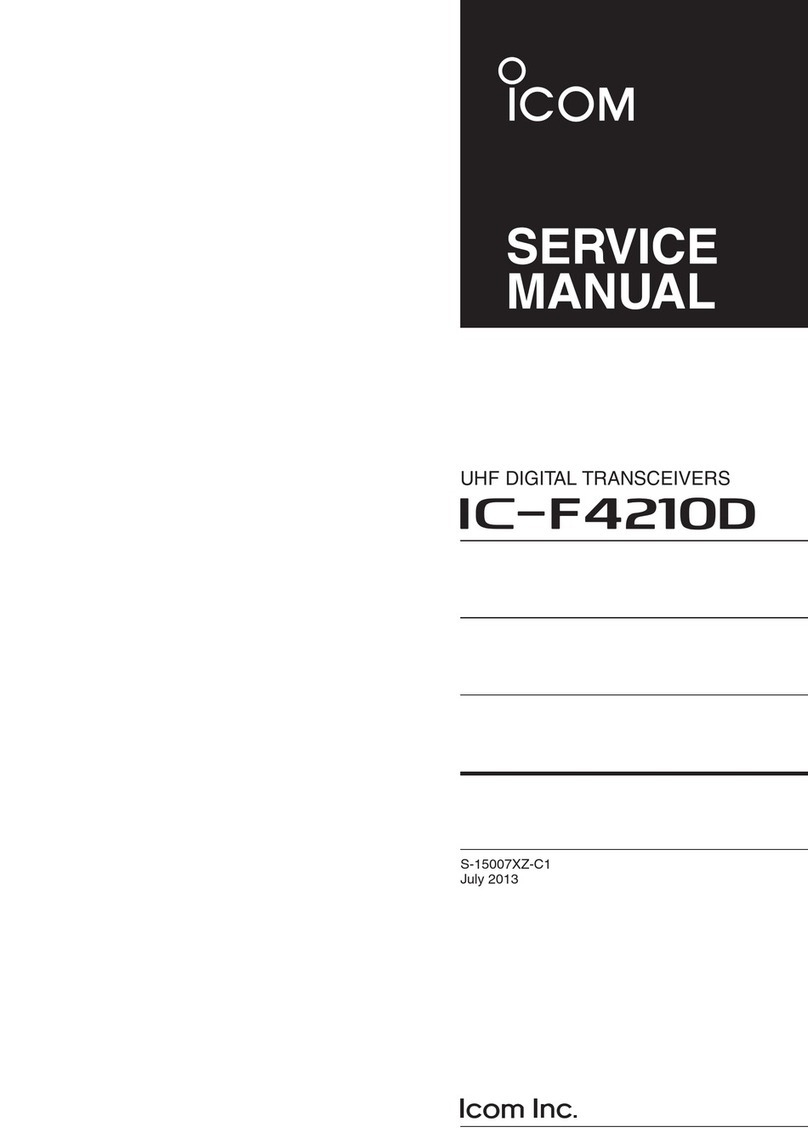
Icom
Icom IC-F4210D Series User manual
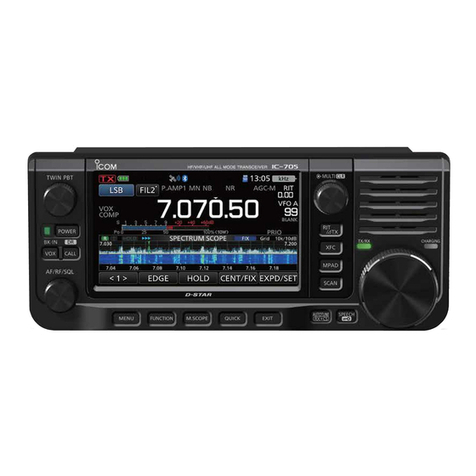
Icom
Icom IC-705 Installation guide
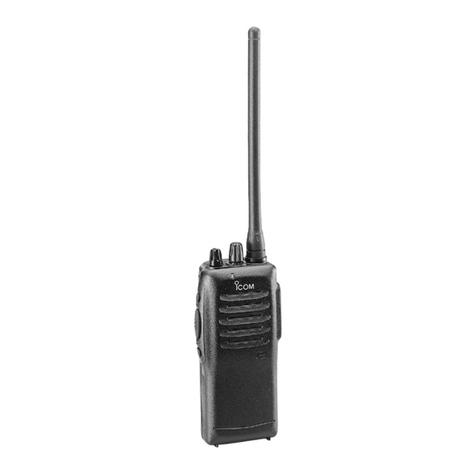
Icom
Icom IC-F21S User manual
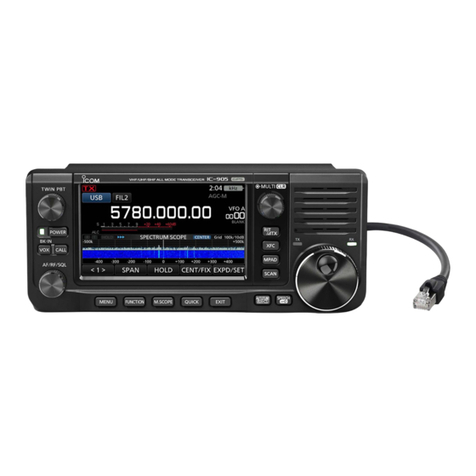
Icom
Icom IC-905 Instruction Manual

Icom
Icom IC-718 User manual
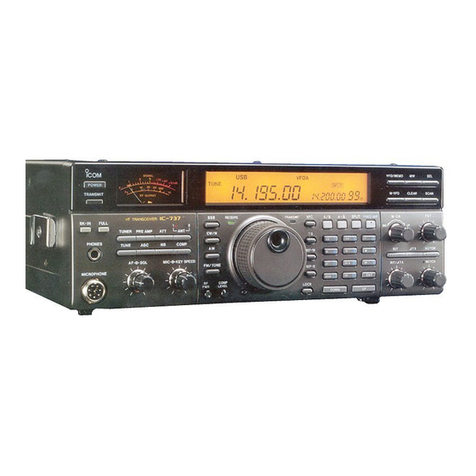
Icom
Icom IC-737 User manual
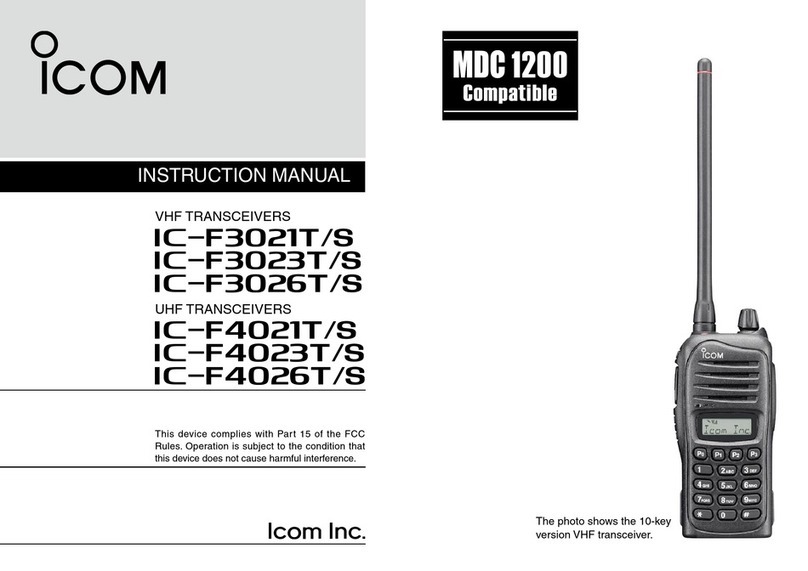
Icom
Icom IC-F3021T/S User manual
